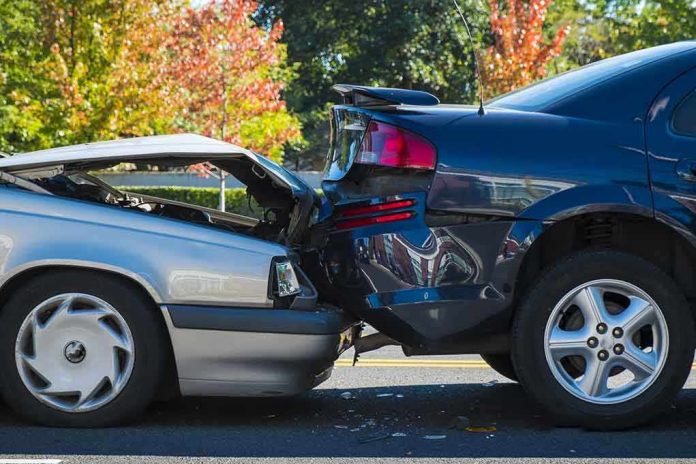
For decades, federal regulators ignored critical differences in how men and women fare in car crashes—now, a bipartisan Senate bill seeks to end this dangerous oversight, potentially saving thousands of lives but raising questions about government priorities and regulatory competence.
Story Snapshot
- The She DRIVES Act would force safety regulators to use female crash test dummies, addressing long-ignored risks for millions of women drivers.
- Government studies show women are 17% more likely to die and 73% more likely to be seriously injured in car accidents than men.
- Bipartisan support pushes the bill closer to passage, with the Senate Commerce Committee unanimously advancing it in August 2025.
- The bill is a response to government agencies’ failure to update standards despite decades of warnings, with advocates estimating over 1,300 lives could be saved annually.
Decades of Regulatory Neglect Endanger Women Drivers
Since the 1970s, federal vehicle safety standards have relied on crash test dummies modeled after the average male body, leaving women at a systemic disadvantage in car safety. Despite clear scientific evidence—supported by multiple studies and government data—that women are far more likely to die or be gravely injured in car crashes, regulators failed to update testing protocols or meaningfully include female dummies. This regulatory inertia persisted even as the Government Accountability Office (GAO) and safety advocates repeatedly sounded the alarm.
The National Highway Traffic Safety Administration (NHTSA), the agency tasked with protecting American drivers, has missed several self-imposed deadlines to modernize testing. The result: in states like Alabama, with over two million licensed female drivers, women now comprise the majority of drivers in several regions—yet federal crash tests still fail to reflect their real-world risk. Prior efforts in Congress to fix this glaring problem stalled, while other countries moved ahead with more representative standards.
Bipartisan Bill Pressures Agencies, Potentially Saves Thousands
The She DRIVES Act, formally introduced as S. 161 in January 2025 after an earlier version stalled, is led by Senators Katie Britt (R-Ala.) and Deb Fischer (R-Neb.), with support from both Republican and Democrat colleagues. This rare bipartisan coalition reflects mounting frustration with bureaucratic delay: lawmakers and advocates argue that the NHTSA’s inaction directly endangers American families. The bill’s backers cite hard numbers: women are 17% more likely to die and 73% more likely to be seriously injured in crashes—a pattern that could be reversed by smarter, more inclusive safety tests.
The Senate Commerce Committee’s unanimous approval in August 2025 marks the bill’s most significant progress to date. If enacted, the legislation would require NHTSA to use advanced crash test dummies that accurately represent female bodies and update testing protocols to reflect real-world conditions for all drivers. Safety groups like the Advocates for Highway and Auto Safety and the Insurance Institute for Highway Safety strongly support these reforms, emphasizing that over 1,300 lives could be saved each year, with tens of thousands of serious injuries prevented.
Real-World Impacts and Conservative Concerns
The She DRIVES Act could bring both immediate and long-term changes to car safety in America. In the short term, it would force NHTSA to update outdated testing methods, making roads safer for women, the elderly, and other vulnerable groups. Over time, the bill promises to reduce fatalities, cut billions in health and insurance costs, and rebuild public trust in government safety standards. However, the legislation also highlights a persistent pattern: federal agencies failing to act until Congress compels them—raising concerns about government accountability and the broader dangers of bureaucratic overreach.
How female crash-test dummies could save thousands of lives https://t.co/n9zO38IWaA
— Observing Time 🏴☠️ (@TimeObserving) September 22, 2025
Automakers, meanwhile, face new compliance and design challenges, but public statements from industry have been cautious, focusing on implementation timelines and costs. For conservative Americans, the story underscores a familiar frustration: vital reforms held hostage by slow-moving agencies and regulatory inertia. While the bill is widely seen as a common-sense fix, it also serves as a warning that government inaction—especially when it comes to protecting families—can have deadly consequences.
Sources:
U.S. Senators Katie Britt, Deb Fischer introduce She DRIVES Act to improve passenger vehicle safety
Fischer reintroduces She DRIVES Act to improve passenger vehicle safety
Advocates for Highway and Auto Safety: 2025 She DRIVES Act
The She DRIVES Act: Revolutionizing Crash Safety Standards







